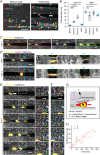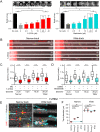Actomyosin contractility requirements and reciprocal cell-tissue mechanics for cancer cell invasion through collagen-based channels
- PMID: 35575822
- PMCID: PMC9110550
- DOI: 10.1140/epje/s10189-022-00182-6
Actomyosin contractility requirements and reciprocal cell-tissue mechanics for cancer cell invasion through collagen-based channels
Abstract
The interstitial tumor microenvironment is composed of heterogeneously organized collagen-rich porous networks as well as channel-like structures and interfaces which provide both barriers and guidance for invading cells. Tumor cells invading 3D random porous collagen networks depend upon actomyosin contractility to deform and translocate the nucleus, whereas Rho/Rho-associated kinase-dependent contractility is largely dispensable for migration in stiff capillary-like confining microtracks. To investigate whether this dichotomy of actomyosin contractility dependence also applies to physiological, deformable linear collagen environments, we developed nearly barrier-free collagen-scaffold microtracks of varying cross section using two-photon laser ablation. Both very narrow and wide tracks supported single-cell migration by either outward pushing of collagen up to four times when tracks were narrow, or cell pulling on collagen walls down to 50% of the original diameter by traction forces of up to 40 nN when tracks were wide, resulting in track widths optimized to single-cell diameter. Targeting actomyosin contractility by synthetic inhibitors increased cell elongation and nuclear shape change in narrow tracks and abolished cell-mediated deformation of both wide and narrow tracks. Accordingly, migration speeds in all channel widths reduced, with migration rates of around 45-65% of the original speed persisting. Together, the data suggest that cells engage actomyosin contraction to reciprocally adjust both own morphology and linear track width to optimal size for effective cellular locomotion.
© 2022. The Author(s).
Conflict of interest statement
We declare we have no competing interests.
Figures





Similar articles
-
Two-photon laser-generated microtracks in 3D collagen lattices: principles of MMP-dependent and -independent collective cancer cell invasion.Phys Biol. 2011 Feb;8(1):015010. doi: 10.1088/1478-3975/8/1/015010. Epub 2011 Feb 7. Phys Biol. 2011. PMID: 21301056
-
Comparative mechanisms of cancer cell migration through 3D matrix and physiological microtracks.Am J Physiol Cell Physiol. 2015 Mar 15;308(6):C436-47. doi: 10.1152/ajpcell.00225.2014. Epub 2014 Dec 10. Am J Physiol Cell Physiol. 2015. PMID: 25500742 Free PMC article.
-
Modeling the two-way feedback between contractility and matrix realignment reveals a nonlinear mode of cancer cell invasion.Proc Natl Acad Sci U S A. 2017 Feb 28;114(9):E1617-E1626. doi: 10.1073/pnas.1617037114. Epub 2017 Feb 14. Proc Natl Acad Sci U S A. 2017. PMID: 28196892 Free PMC article.
-
The matrix environmental and cell mechanical properties regulate cell migration and contribute to the invasive phenotype of cancer cells.Rep Prog Phys. 2019 Jun;82(6):064602. doi: 10.1088/1361-6633/ab1628. Epub 2019 Apr 4. Rep Prog Phys. 2019. PMID: 30947151 Review.
-
Forcing cells into shape: the mechanics of actomyosin contractility.Nat Rev Mol Cell Biol. 2015 Aug;16(8):486-98. doi: 10.1038/nrm4012. Epub 2015 Jul 1. Nat Rev Mol Cell Biol. 2015. PMID: 26130009 Free PMC article. Review.
Cited by
-
Microinterfaces in biopolymer-based bicontinuous hydrogels guide rapid 3D cell migration.Nat Commun. 2024 Mar 29;15(1):2766. doi: 10.1038/s41467-024-46774-y. Nat Commun. 2024. PMID: 38553465 Free PMC article.
-
Confinement-sensitive volume regulation dynamics via high-speed nuclear morphological measurements.Proc Natl Acad Sci U S A. 2024 Dec 24;121(52):e2408595121. doi: 10.1073/pnas.2408595121. Epub 2024 Dec 19. Proc Natl Acad Sci U S A. 2024. PMID: 39700138 Free PMC article.
-
Tensions on the actin cytoskeleton and apical cell junctions in the C. elegans spermatheca are influenced by spermathecal anatomy, ovulation state and activation of myosin.bioRxiv [Preprint]. 2024 Sep 5:2024.09.03.611016. doi: 10.1101/2024.09.03.611016. bioRxiv. 2024. Update in: Front Cell Dev Biol. 2024 Oct 15;12:1490803. doi: 10.3389/fcell.2024.1490803. PMID: 39282271 Free PMC article. Updated. Preprint.
-
Confined cell migration along extracellular matrix space in vivo.Proc Natl Acad Sci U S A. 2025 Jan 7;122(1):e2414009121. doi: 10.1073/pnas.2414009121. Epub 2024 Dec 30. Proc Natl Acad Sci U S A. 2025. PMID: 39793073 Free PMC article.
-
Cell jamming in a collagen-based interface assay is tuned by collagen density and proteolysis.J Cell Sci. 2023 Dec 1;136(23):jcs260207. doi: 10.1242/jcs.260207. Epub 2023 Dec 15. J Cell Sci. 2023. PMID: 37987169 Free PMC article.
References
MeSH terms
Substances
Grants and funding
LinkOut - more resources
Full Text Sources

